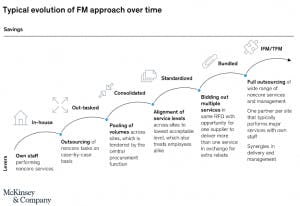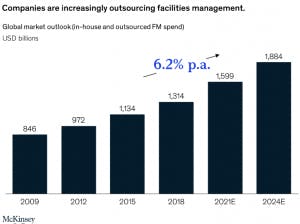
6 emerging trends in Facility Management services
Outsourcing, workplace strategies and technological innovations have huge potential for companies that seek to reduce costs and improve productivity in on-site management.
For companies with distributors-retailers, manufacturers, transportation and logistics-management services can represent 10 to 25 percent of total indirect costs. Many recent developments, such as fears of recession, trade disputes, technology disruptions and rising wages, have made cost reduction a higher priority in this area. However, entrepreneurs need to strike a difficult balance to reduce non-core costs without affecting the performance of key operations.
Companies have no shortage of options at their disposal to optimize facility management costs. Outsourcing is a well-established strategy that grows thanks to the influx of suppliers, while integrated approaches to facility management, workplace strategy and technology are all promising. The global market for indoor and outdoor facilities is estimated to reach $ 1.9 trillion by 2024. The exterior represents more than half of the total and has attracted a growing number of suppliers with new service offerings. Still, charting a clear path forward – one that allows companies to make the most of it – is an increasingly complex task.
How should companies proceed? As a first step, executives need to become familiar with how six emerging trends could reduce plant management costs and improve productivity. The first three concern the implementation of existing strategies and approaches. The next three include the use of technology to transform the way businesses do business. However, these trends are not plug and play. Companies must have the right strategy and capabilities to make the most of their potential. Facility management and hiring leaders need to focus on several immediate steps to mobilize their organization and follow these trends.
The evolution of the facility management strategy
When faced with ongoing pressures to reduce operating costs, companies tend to look for savings without thinking much about the long-term effects. This dynamic makes facility management a particularly mature goal. During difficult economic times, companies reduce their facility management budgets. When prospects recover, spending levels often remain low. This design can lead to deteriorating condition of buildings and equipment, possibly costing more in the long run.
Over the years, industries have accepted outsourcing as a viable option for non-core businesses, including facility management. Companies typically follow a trend that begins with outsourcing non-saturated operations to individual locations (Presentation 1). The consolidation, standardization and grouping of these tasks in all facilities over time results in the outsourcing of an integrated set of services and management without third party to third parties.

Various economic factors have made outsourcing more relevant to the management of the facility. Growth is slowing in several large countries as they reach the end of the current economic cycle. Prolonged global trade conflicts have led to unexpected changes in commodity and commodity prices. Meanwhile, rising technology disruptions in a number of industries are pushing old-fashioned companies to release cash for technology investments. Finally, lower unemployment rates push higher wage rates for the best talents. Thanks to these developments, the total facility management market (domestic and foreign) is expected to grow by more than 6% per year from 2018 to 2024, hitting almost $ 1.9 trillion (Appendix 2).

Facility management is ripe for disruption: it lags behind other functions such as maintenance of production equipment with both digital maturity and technology penetration. Although technology is available to manage the facility, many barriers have hindered adoption, such as a lack of digital skills in operation, other priorities for leadership, and a focus on continued cost reduction. These factors have made the outsourcing facility management market attractive to top sellers who are already directly or indirectly involved with this feature. Many incumbents have developed a comprehensive facility management offering in an effort to gain greater market share.
Six emerging trends
We have identified six trends that today offer opportunities for cost savings or productivity improvements that could transform facility management over the next decade. Since the attractiveness of any trend will depend on the needs and capabilities of an organization, trends are presented in a way that facilitates evaluation and comparison.
Outsourcing of facility management
Integrated value and related services
Workplace strategy
The evolution of the Internet of Things (IoT)
The appearance of robots
Augmented reality
Detailed trends in our next article.